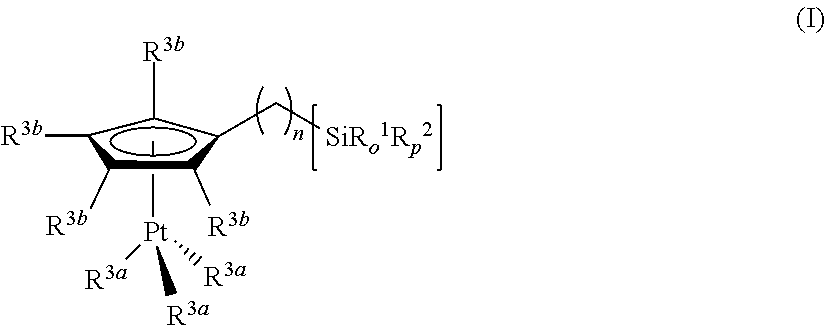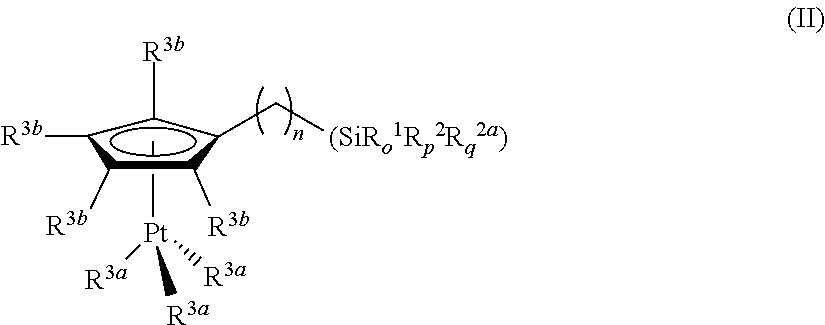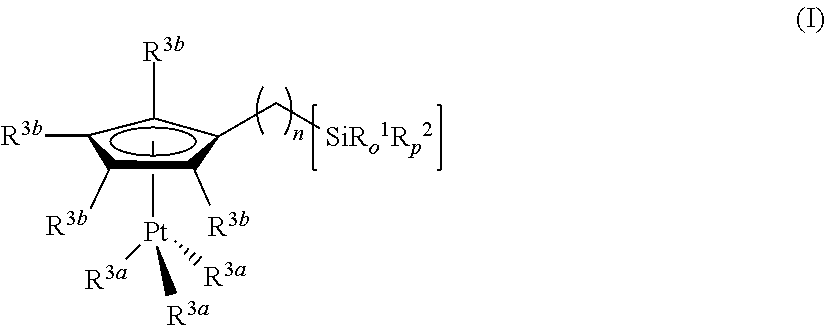Hydrosilylation reactions activated through radiation
- Summary
- Abstract
- Description
- Claims
- Application Information
AI Technical Summary
Benefits of technology
Problems solved by technology
Method used
Image
Examples
example 1
Preparation of the Cyclopentadienyl-Functionalized Silane 1
[0226]27.5 g (417 mmol) of freshly distilled cyclopentadiene are added dropwise to a suspension of 15 g (417 mmol) of sodium hydride in 250 ml of absolute tetrahydrofuran at room temperature over a period of one hour. 100.3 g of (3-chloropropyl)triethoxysilane are subsequently added dropwise over a period of 30 minutes. The solution becomes warm during this process. After taking off the solvent, the mixture is fractionally distilled in an oil pump vacuum to give 96.1 g of (3-cyclopenta-dienylpropyl)triethoxysilane (yield: 90%).
example 2
Preparation of the Cyclopentadienyl-Functionalized Silane 2
[0227]27.5 g (417 mmol) of freshly distilled cyclopentadiene are added dropwise to a suspension of 10 g (417 mmol) of sodium hydride in 250 ml of absolute tetrahydrofuran at room temperature over a period of one hour. 76.1 g of (3-chloropropyl)dimethoxymethylsilane are subsequently added dropwise over a period of 30 minutes. The solution becomes warm during this process. After taking off the solvent, the mixture is fractionally distilled in an oil pump vacuum to give 68.6 g of (3-cyclopentadienylpropyl)dimethoxy-methylsilane (yield: 83%).
example 3
Preparation of the Cyclopentadienyl-Functionalized Silane 3
[0228]33.4 g (417 mmol) of freshly distilled methylcyclopentadiene are added dropwise to a suspension of 10 g (417 mmol) of sodium hydride in 250 ml of absolute diethyl ether at RT over a period of one hour. 76.1 g of (3-chloropropyl)dimethoxy-methylsilane are subsequently added dropwise over a period of 30 minutes. The solution becomes warm during this process. After taking off the solvent, the mixture is fractionally distilled in an oil pump vacuum to give 78.9 g of (3-methylcyclopentadienylpropyl)dimethoxy-methylsilane (yield: 89%).
PUM
| Property | Measurement | Unit |
|---|---|---|
| Temperature | aaaaa | aaaaa |
| Temperature | aaaaa | aaaaa |
| Fraction | aaaaa | aaaaa |
Abstract
Description
Claims
Application Information
 Login to View More
Login to View More - R&D
- Intellectual Property
- Life Sciences
- Materials
- Tech Scout
- Unparalleled Data Quality
- Higher Quality Content
- 60% Fewer Hallucinations
Browse by: Latest US Patents, China's latest patents, Technical Efficacy Thesaurus, Application Domain, Technology Topic, Popular Technical Reports.
© 2025 PatSnap. All rights reserved.Legal|Privacy policy|Modern Slavery Act Transparency Statement|Sitemap|About US| Contact US: help@patsnap.com



